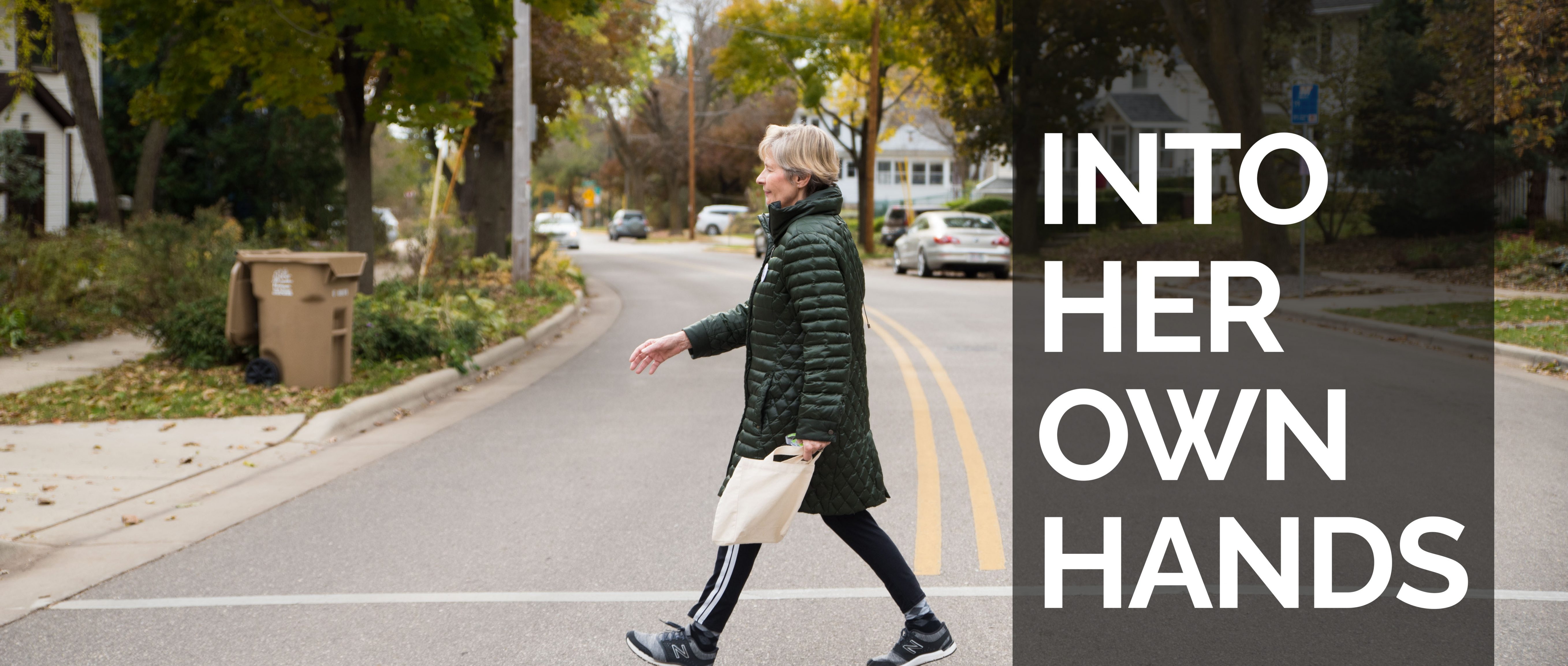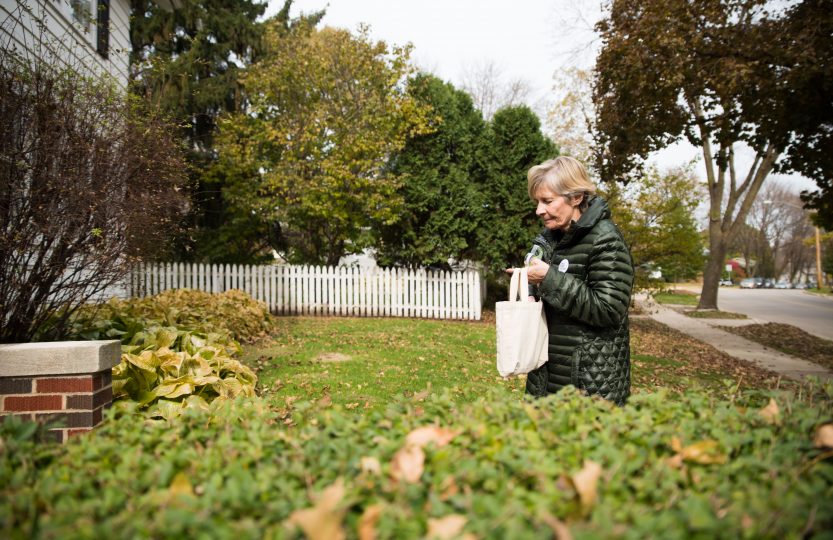
 It started with a tremor in her left hand.
It started with a tremor in her left hand.
Karen Bate thought she had essential tremor, a nervous system disorder causing shaking, until her physician recommended she see a neurologist.
“And then, boom,” Bate says.
She had Parkinson’s disease.
Bate was shocked. “I felt like my life was over,” she says. “My first thought was, ‘I can’t do this.’” She was 63 and single at the time. She had just retired from her job as a teacher.
“I had all these plans,” Bate says. “I wanted to volunteer and do things, just helping other people, and pretty soon I’m the one that needs to be helped.”
It’s not the first time Bate overcame adversity. After having three daughters, she went through a devastating divorce. She was a stay-at-home mom then, but got a job teaching in Madison. She won awards for her work and successfully raised her girls into adulthood.
Then, in November 1999, her youngest daughter was killed in a car accident.
The pain of divorce was nothing compared to that of losing a child, Bate says. The loss threw her back into a period of grief, but she relied on her spirituality as a source of strength.
“I never dreamed I would have to go through something else this difficult,” Bate says. “We’re all gonna get something. You think it’s going to be a heart attack or something that’s going to go quick. You don’t think of something being dragged out.”
Eight years have passed since her diagnosis. The medication she takes stops the tremor, but it causes dyskinesia, marked by involuntary muscle movements, and her neck moves “all over the place,” she says.
“I’m getting used to the fact that I look like I’m shaking all over, but I just forget about it — because otherwise, I’d just be marooned in my house all day long, and that’s not good either,” Bate says.
Bate struggles to write and cook. Her tremor is more significant. She has nearly constant pain in her legs.
She also has a plan.
“If it doesn’t kill you, it makes you stronger,” Bate says. “I felt like I’ve probably almost been killed, but then I go through a period of a bit of grief, and then I get into the acceptance phase, and then I move forward. That’s basically all you can do if you want to still be in this world.”







By the time symptoms typically start to show, an individual has had Parkinson’s for between 10 and 20 years. The neurodegenerative disorder, which has no known cause or cure, is common among older adults — the average age of diagnosis is 65, or at the midstage of the disease — but some people are diagnosed as early as their 30s or 40s.
If an individual with Parkinson’s looks back toward the nonspecific symptoms they experienced up to 20 years ago, they can piece together the early signs of the disease. Sleep problems, changes to sense of smell, heartburn, depression, anxiety and orthostatic hypotension — when an individual’s blood pressure decreases as they stand up instead of increasing like it’s supposed to — are all symptoms of Parkinson’s. But, just because an individual has one or more of these symptoms does not mean they have the disease.
“Some of these are all things that happen as precursors,” says Michelle Ciucci, an associate professor in the Division of Otolaryngology – Head & Neck Surgery at UW-Madison. “But all those things on their own wouldn’t necessarily trigger [a specific concern about Parkinson’s]. A lot of people just attribute these things to normal aging.”
A tremor like Bate’s occurs around the midstage of the disease, and it’s one of the “cardinal” symptoms of Parkinson’s, along with slow movement and rigidity.
“There’s this real opportunity to try to identify early, but we’re not really sure what the specific diagnostic criteria should be, necessarily,” Ciucci says.
There are no specific and measurable physical traits, known as biomarkers, that indicate Parkinson’s. A diagnosis can take six months to a year, too. Physicians and specialists look for two or more of the cardinal symptoms of Parkinson’s. Doctors consider a patient’s medical and medication history, and patients undergo a neurological exam. Responsiveness to Parkinson’s medications provide further evidence for diagnosis.
Parkinson’s progresses slowly. It manifests itself in limited mobility, balance problems, muscle rigidity, speech difficulties and trouble swallowing. Eventually, fine motor control decreases, people struggle to dress themselves and experience cognitive deficits, posture becomes stooped, and depression or a form of dementia particular to Parkinson’s can develop.
“The good news is there’s things that you can do like exercise and take care of yourself, and that really helps stave it off,” Ciucci says. “Now that our understanding of the disease is expanded, our repertoire of treatment is also expanded.”
“When you don’t know what causes something in your life, it’s so good to find out what the cause is, and then you have answers, and you stop wondering”
Research yields new medications all the time. Physical exercise, speech therapy and brain surgery all help to slow the progression of physical and mental degeneration. Bate does anything she can to stay active — from Zumba and rowing classes to boxing at a studio dedicated to those with Parkinson’s.
Occasionally, sadness and fear took over, Bate says, stemming from Parkinson’s-related depression and anxiety. “Sometimes I would sit there and do the exercises with tears streaming down my face,” she says. But, soon, she started enjoying the classes.
“It helps put off the progression,” Bate says. “I used to pride myself on saying, ‘I never sweat.’ Wrong about that. I don’t think I’ve ever exerted myself that much.”
People ask her why she takes so many classes.
“I said, ‘You know what motivates me to do it? Fear,’” she says. “We have to learn to cope with each new stage of degeneration, and so you have to keep yourself strong.”
Bate steels herself for the prospect of brain surgery, too. The procedure, called deep brain stimulation, involves implanting electrodes in areas of the brain. The electrodes produce electrical impulses, which regulate specific cells and chemicals in the brain. If all goes well, symptoms like a tremor could improve, decreasing the need for medications. For Bate, the scariest part of the surgery involves sitting awake for six hours while the surgeons saw through her skull to place the electrodes.
Patients remain awake so the neurologist can talk to them and ensure the correct areas of the brain are stimulated and placement is correct. And, there are potentially serious complications.
“I’m trying to get up the nerve and the guts to have that done,” Bate says. “I’m thinking, ‘Golly, my symptoms are getting worse, they’ll only continue to get worse, so why not try this?’ I’ve just got to take the plunge and do it.”
Bate’s life adjustments since her diagnosis aren’t as significant as transforming from a yogi to a boxer or receiving potentially life-changing brain surgery.
She bought a water purifier four years ago when she started to read about potentially contaminated water and its possible, but inconclusive, link to Parkinson’s. The silver cylinder sits next to her kitchen sink.
Bate was once afraid of researching Parkinson’s online, too. Now, she’s digging in. When she finds good information, she passes it along to as many people as she can in the Parkinson’s community. She conducts a “little ministry” for newly diagnosed individuals who get her name and number from a psychologist, the Wisconsin Parkinson Association, or another resource and call her for advice.
“I just try to be real upbeat and tell them all about what’s going on here and really encourage them, because it’s a pretty devastating diagnosis,” Bate says.
Bate turns to her family, too. She has a supportive husband, who she married two years ago, and she gets together with her siblings who live in the Midwest. One of her daughters, a physical therapist in California, says individuals with Parkinson’s are her favorite people to work with.
Bate’s other daughter, who lives in Wisconsin, has strong faith like Bate.
“Sometimes I feel like she’s my mother because she encourages me through a lot of things,” Bate says. “I think you absolutely need people,” Bate says. “I know I couldn’t do it by myself because I probably would get kind of bitter and say, ‘Oh, why me again?”
Bate’s other endeavor started on a rainy day when she stopped at a garage sale a block from her house in the Dudgeon-Monroe neighborhood of Madison where she’s lived for 45 years. The homeowner asked Bate if she had Parkinson’s, then informed her that a man up the street also had it.
At her Parkinson’s Zumba class, Bate saw a woman who had once lived on the same street as the man but moved away several years ago.
Bate then learned that her former neighbor, who died about 15 years ago, had Parkinson’s. This meant that four people on her block, including her, had the disease.
Bate typed up a note to post on homes throughout the neighborhood in an effort to find more individuals with Parkinson’s and try to find a possible cause. She started to receive emails from residents who had Parkinson’s or knew of someone who did. Bate discovered 15 people with Parkinson’s living less than a mile from one another.
Bate found that troubling. She knew of the environmental risk factors. Research shows chemicals used in certain professions like welding and farming, long-term exposure to pesticides and herbicides, and water contaminated by the solvent trichloroethylene and polychlorinated biphenyls, known as PCBs, are all associated with Parkinson’s, but the research isn’t conclusive.
“These people are kind of jumping into my space, and so I just felt [that] I’ve gotta do something about this, and follow through and see if there’s anything I can do,” Bate says. “I’ve got Parkinson’s, but I’m just concerned about all the other people in the neighborhood.”
Exposure to environmental factors doesn’t mean a person will develop Parkinson’s. A person’s genetic makeup can make them more or less vulnerable to the effects of particular substances.
The specific cause of Parkinson’s remains unknown. “But I still think it’s a good cause,” Bate says. “If we can remove something in the environment, or clean it up, and as soon as we can, that’s what my goal is, too.”
Bate and her husband have distributed more than 600 notes throughout their neighborhood. She created a survey that she’d like to distribute next, and she hopes to meet with others living with Parkinson’s in her neighborhood.
“I’m not a scientist,” Bate says. “I’ve always had this curious mind to find out why things happen.”
She’s at the beginning stages of her journey, but her project has given her hope for the future and motivation to gather any information she can.

“When you don’t know what causes something in your life, it’s so good to find out what the cause is, and then you have answers, and you stop wondering,” Bate says. “The best thing is just to learn how to go with it. You just pull yourself up and start again, and just keep hoping. Hope is a big thing.”
The responses she’s received thus far encourage her. Several neighbors have come forward with their diagnosis, and other residents have simply sent her kind words of encouragement or expressed their concerns, too.
“That’s what motivates me, really,” Bate says. “I’m not gonna get Parkinson’s. I’ve already got it. And if I can play a small part in figuring out some answers, that would be a real blessing for me. To just help.”
She reflects on her favorite boxing class and a poster that hangs on the wall of the studio. It shows a person holding their arms up as if flexing their muscles while sporting a T-shirt that reads “Fighting back.”
“It is kind of like a fight to just keep going and keep motivated,” Bate says. “It’s either crawl in a hole, or get out and fight as hard as you can.”

Cathleen is one of the publication's lead writers and a second-year graduate student studying journalism with a focus in community and civic engagement reporting.